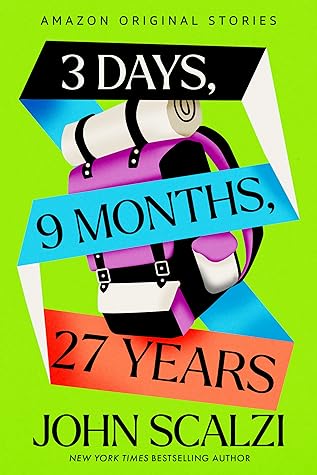More on this book
Community
Kindle Notes & Highlights
by
John Scalzi
Read between
November 15 - November 15, 2025
To the observer, which is to say, me, the theoretical process is simple. The client enters the chamber to the left, through the door, carrying with them everything they have chosen to take on their journey, usually in a backpack. Inside the first chamber, everything they are taking is laid out on the bench and on the floor if space on the bench runs out. The chamber is flooded with sterilizing light and gas, a final attempt to keep the destination safe from any germ or disease the client might carry with them. The client closes their eyes and holds their breath. This is, for various reasons,
...more
The retrieval intervals, as we call them, correspond to temporal resonances, ripples in the timestream, generated when we drop an object into it, in this case, the client. In the orientation session I received when I joined the organization as a technician, I was provided a 5brief gloss of the physics involved, and how the intervals were due to quantum fluctuations and nested dimensions and other such abstruse concepts. I appreciated that the organization wanted me to understand these things, but at the end of the day I was hired to push buttons, move the clients through the exit and reentry
...more
This is a really clever way of avoiding a lengthy, complicated,and in all likelihood infeasible discussion of the science here (which really isn’t important anyway), yet doing so seamlessly within the story’s own internal logic.
We are told of the great fears of the dangers of time travel and whether traveling to the past would warp and change the present, and how, not unlike the pre-Trinity concern that a nuclear blast could ignite the earth’s entire atmosphere, a human-scale test of time travel might wipe out the history of the planet. We did it anyway, because humans can’t not stick their fingers into wall sockets (this is a personal observation, not an organizational conclusion). We are told we did not wipe out history. Instead we learned that reality branched at the juncture of the future meeting the past.
...more
The average person does not understand or care how a lizard going one direction and not another, or an energized particle hitting a sensor rather than a rock, matters at all in the grand scheme of things. A scientist, however, knows that initial conditions are everything, and that small differences at the outset make for huge differences in results down the line. The observer and the observed always interact. Everything changes. Send a historian to observe, say, the assassination of Julius Caesar, and their presence changes the scene. There is one more person present at the murder who wasn’t
...more
You can’t be “careful” and attempt to interact only minimally; one can’t know which actions, however seemingly trivial, will be directly consequential, immediately or over time. Every step changes everything, always. It took years, and many arguments about the truth, before historians accepted that time travel could not tell you what “really” happened in the history of our own reality, and that, as every trip back branched into a different reality, every trip back would likewise produce differently inaccurate results. Terrible for historians, but great for our organization. If time travel
...more


